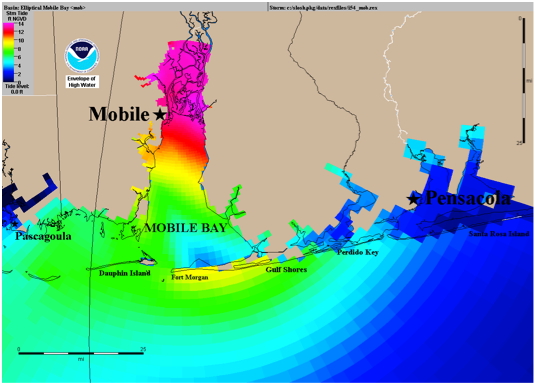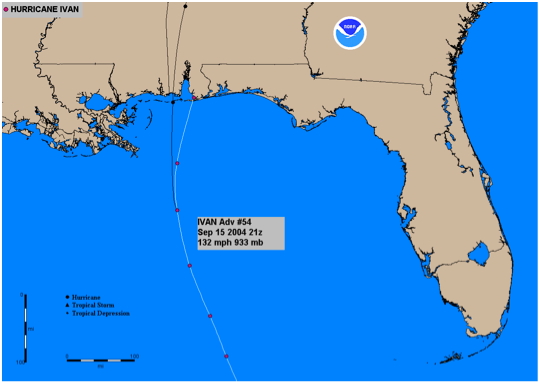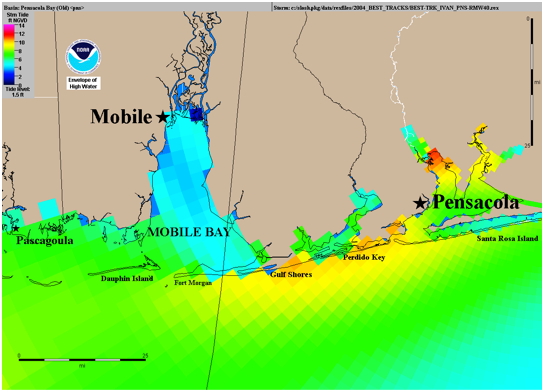 Back to Tropical Cyclones
Forecasting Page | Back
to Main FAQ Page
Subject: F7) How is storm surge forecast at NHC?
Back to Tropical Cyclones
Forecasting Page | Back
to Main FAQ Page
Subject: F7) How is storm surge forecast at NHC?
Contributed by the NHC Storm Surge Unit
The Sea, Lake, and Overland Surges from Hurricanes (SLOSH) model is the
computer model utilized by the National Oceanic and Atmospheric Administration
(NOAA) for coastal inundation risk assessment and the operational prediction
of storm surge.
The eastern seaboard and Gulf Coast of the United States, Puerto Rico, the
Bahamas, the Virgin Islands, and Hawai'i, are subdivided into 39 regions or
"basins." These areas represent sections of the coastline that are centered
upon particularly susceptible features: inlets, large coastal centers of
population, low-lying topography, and ports. The SLOSH model computes the
maximum potential impact of the storm in these "computational domains" based
on storm intensity, track, and estimates of storm size provided by hurricane
specialists at NHC.
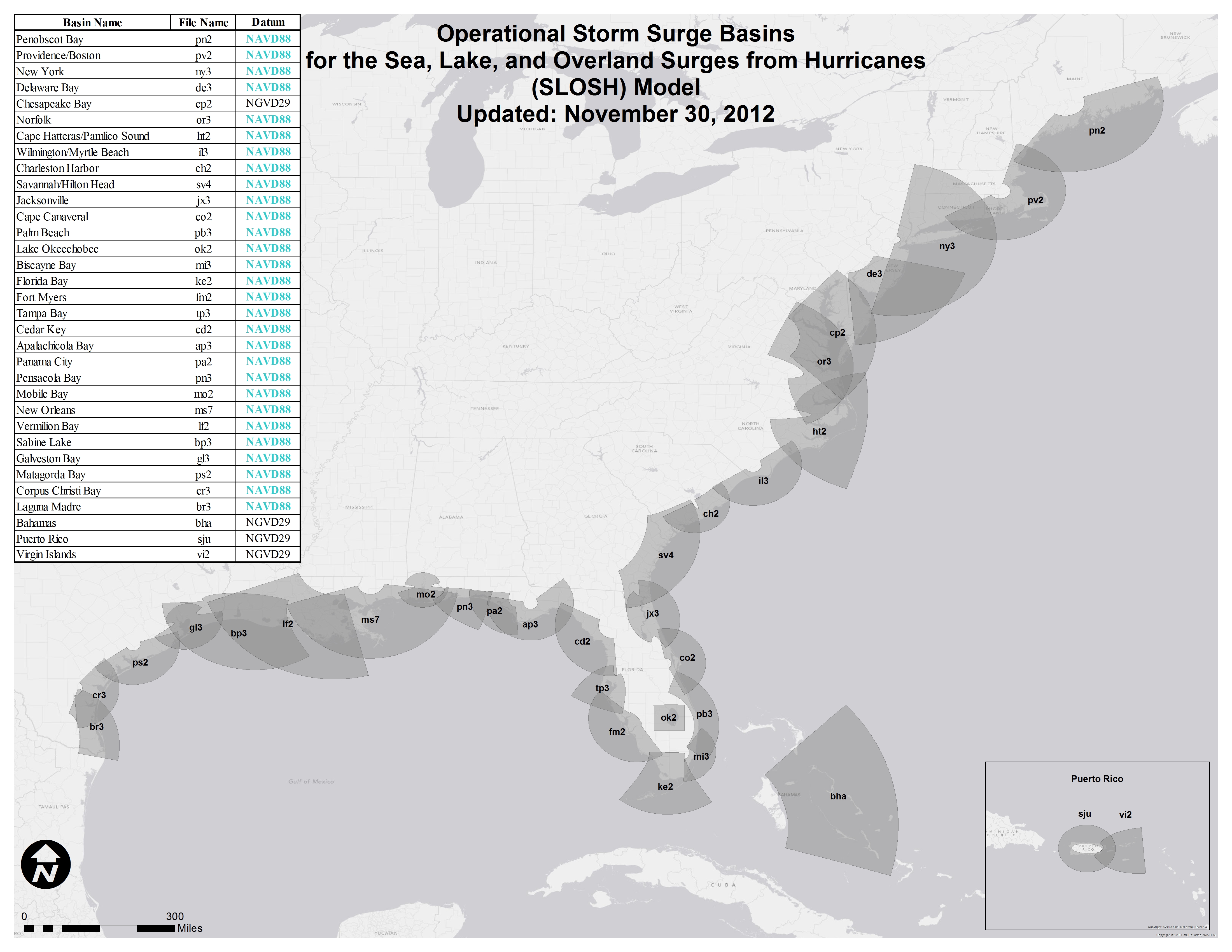
SLOSH model basin coverage
Currently, SLOSH basins are being updated at an averate rate of 6 basins per
year. SLOSH basin updates are ultimately governed by the Interagency
Coordinating Committee on Hurricanes (ICCOH). ICCOH manages hazard and
post-storm analysis for the Hurricane Evacuation Studies under FEMA's
Hurricane Program. Updates are driven by a number of different factors
such as: changes to a basin's topography/bathymetry due to a hurricane event,
degree of vulnerability to storm surge, availability of new data, changes to
the coast, and addition of engineered flood protection devices (e.g. levees).
Sometimes these updates include higher grid size resolution to improve surge
representation, increasing area covered by hypothetical tracks for improved
accuracy, conversion to updated vertical reference
datums, and including the latest topography or bathymetric data for better
representation of barrier, gaps, passes, and other local features.
The SLOSH model can generate sevel different products :
- Deterministic runs
This is an operational product based on the official NHC track and
intensity forecast of a tropical cyclone. Operational SLOSH runs are
generated whenever a hurricane warning is issued, approximately 36 hours
prior to arrival of tropical storm winds. It is run every 6 hours
coinciding with the full advisory package. This is a single run product
which can result in uncertainty because it is STRONGLY dependent on the
accuracy of the storm track and timing. This product is intended to
provide valuable surge information in support of rescue and recovery efforts.
- Probabilistic runs (P-surge)
This is a graphical product using an ensemble of many SLOSH runs to
create a Probabilistic Storm Surge (P-Surge) product. This is intended
to be used operationally so it is based on NHC's official advisory. P-Surge
uses SLOSH-based simulations which are based on statistics of past performance
of the advisories. These different SLOSH simulations are based on the
distribution of :
- Cross-track error (impacts landfall location)
- Along-track error (impacts foreward speed and timing)
- Intensity error (impacts pressure)
- Size error (impacts size)
P-Surge is available whenever a hurricane watch or warning is in effect. It
is posted on the NHC webpage within approximately 30 minutes after the
advisory release time.
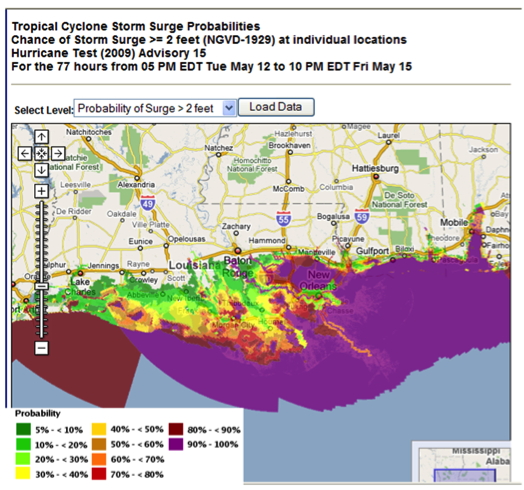
Example of P-Surge output
- Maximum Envelope of Water (MEOW) runs
This is an ensemble product representing the maximum height of storm surge
water in a given basin grid cell using hypothetical storms run with the same:
- Category (intensity)
- Foreward speed
- Storm trajectory
- Initial tide level
Internally a number of parallel SLOSH runs with same intensity, forward speed,
storm trajectory, and initial tide level are performed for the basin. The
only difference in runs is that each is conducted at some distance to the left
or right of the main track (typically at the center of the grid). Each
component run computes a storm surge value for each grid cell. For example,
five parallel runs may yield storm surge values of 4.1, 7.1, 5.3, 6.3, and 3.8
feet. In this case, the MEOW for the cell is 7.1 ft. It is unknown (to the
user) which track generated the MEOW for a particular cell, so it is entirely
possible that the MEOW values for adjacent cells may have come from different
runs. MEOWs are used to incorporate the uncertainties associated with a
given forecast and help eliminate the possibility that a critical storm track
will be missed in which extreme storm surge values are generated.
MEOWs provide a worst case scenario for a particular category, forward
speed, storm trajectory, and initial tide level incorporating uncertainty in
forecast landfall location. The results are typically generated from
several thousand SLOSH runs for each basin. Over 80 MEOWs have been generated
for some basins. This product provides useful information aiding in hurricane
evacuation planning.
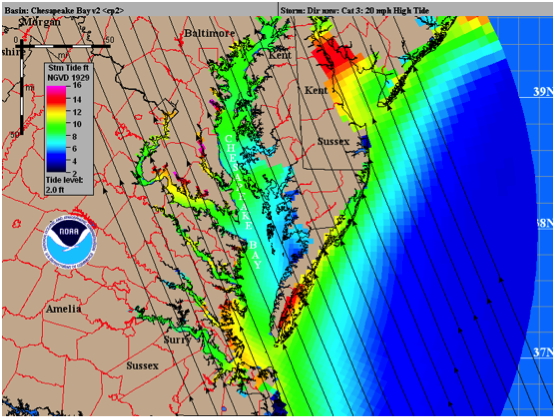
Example of MEOW output
(NNW;Cat 3;20 mph;High Tide)
Each parallel line represents a different track used in the creation
of this MEOW
- Maximum of MEOW (MOM) runs
This is an ensemble product of maximum storm surge heights for all
hurricanes of a given category regardless of forward speed, storm trajectory,
landfall location, etc.. MOMs are created internally by pooling all the MEOWs
for a given basin, separated by category and tide level (zero/high), and
selecting the MEOW with the greatest storm surge value for each basin grid cell
regardless of the forward speed, storm trajectory, landfall location, etc.
This procedure is done for each category of storm. Essentially, there is 1
MOM per storm category and tide level (zero/high). MOMs represent the worst
case scenario for a given category of storm under "perfect" storm conditions.
The MOMs provide useful information aiding in hurricane evacuation
planning and are also used to develop the nation's evauation zones.
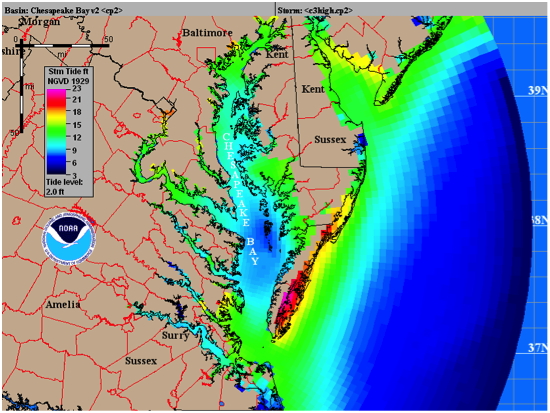
Example of Cat 3 MOM output
Strengths and limitations of SLOSH
The SLOSH model is computationally efficient resulting in fast computer runs.
It is able to resolve flow through barriers, gaps, and passes and models
deep passes between bodies of water. It also resolves inland inundation
and the overtopping of barrier systems, levees, and roads. It can even
resolve coastal reflections of surges such as coastally trapped Kelvin
waves. However it does not model the impacts of waves on top of the surge,
account for normal river flow or rain flooding, nor does it explicitly
model the astromical tide (although operational runs can be run with
different water level anomalies to model conditions at the onset of operational
runs).
Last updated May 14, 2010
Back to Tropical Cyclones
Forecasting Page | Back
to Main FAQ Page

